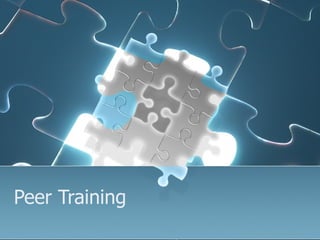Peer Training
- 2. What’s Driving Peer Training? technology demands budget constraints rapid change certification requirements increased need for quality in products and services
- 3. OJT vs. Peer Training
- 4. OJT vs. Peer Training Typical OJT Peer Training
- 5. OJT vs. Peer Training Typical OJT anybody can get drafted to train Peer Training
- 6. OJT vs. Peer Training Typical OJT anybody can get drafted to train Peer Training identified peer trainers
- 7. OJT vs. Peer Training Typical OJT anybody can get drafted to train different trainers = different approaches Peer Training identified peer trainers
- 8. OJT vs. Peer Training Typical OJT anybody can get drafted to train different trainers = different approaches Peer Training identified peer trainers all peer trainers use the same approach
- 9. OJT vs. Peer Training Typical OJT anybody can get drafted to train different trainers = different approaches trainers’ skills vary widely Peer Training identified peer trainers all peer trainers use the same approach
- 10. OJT vs. Peer Training Typical OJT anybody can get drafted to train different trainers = different approaches trainers’ skills vary widely Peer Training identified peer trainers all peer trainers use the same approach coherent development of trainers’ skills
- 11. Impact of Inconsistent OJT Negative impact on: job performance productivity quality customer satisfaction
- 12. Benefits of Peer Training greater control over job performance improved quality employee development pool of qualified trainers ROI
- 13. The Training Model Knowledge Acquisition Skill Development Job Performance Organizational Impact PRACTICE TRANSFER MOTIVATION SUPPORT
- 14. 7 Step Training Model 1. Prepare 2. Make effective contact 3. Clarify the task 4. Check knowledge and skills 5. Train 6. Evaluate mastery 7. Feedback/next steps
- 15. Checking Comprehension I know it. I’m explaining it. So, my student must be “getting” it.
- 16. Ã˝
- 17. Checking Comprehension When to check when you’ve covered a lot of material when you’ve been doing all the talking, showing, or demonstrating, and your student hasn’t been doing much when you’re about to make a transition when your student gets that lost, glazed look - or looks a little anxious
- 18. Giving Feedback Tips be helpful mix the positive with the negative be specific not vague be descriptive not evaluative follow up feedback to check understanding
- 19. Using Documentation in Training The Training Checklist Field Trainer/Coach documents activity Student initials when activity is completed Post New Hire follow-up


















